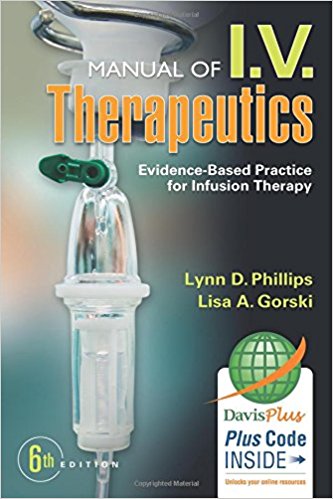Description
I.V. Therapeutics Evidence-Based Practice for Infusion Therapy 6th Edition by Lynn Dianne – Test Bank
Chapter 3: Fundamentals of Fluid and Electrolyte Balance
Multiple Choice
Identify the choice that best completes the statement or answers the question.
____ 1. A nurse is assessing an older adult client who is disoriented to time and place. The nurse notes that the client’s eyes are sunken, the mouth is coated, the tongue has an extra longitudinal furrow, and the client’s lips are cracked. The client’s hand vein filling takes more than 5 seconds; tenting is apparent over the sternum; and the vital signs are BP 110/60 mm Hg, pulse 62, and respiratory rate of 12. Based on these assessment findings, which fluid or electrolyte imbalance should the nurse suspect?
|
a. |
Sodium excess |
|
b. |
Magnesium deficit |
|
c. |
Fluid volume deficit |
|
d. |
Fluid volume excess |
____ 2. A nurse prepares to assess a client who has been vomiting for several days. For which signs of fluid volume deficit (FVD) should the nurse assess?
|
a. |
Bounding pulse, decreased blood pressure, and moist crackles |
|
b. |
Dyspnea, jugular vein distention, and sternum fingerprinting |
|
c. |
Increased pulse rate, decreased blood pressure, and poor skin turgor |
|
d. |
Increased respiratory rate; warm, moist skin; and decreased body temperature |
____ 3. A nurse assesses a client who has moist crackles (rales) in the lung bases, an increased respiratory rate, dyspnea, and 3+ edema of the ankles. Which is the most accurate nursing diagnosis for this client?
|
a. |
Fluid volume deficit |
|
b. |
Fluid volume excess |
|
c. |
Impaired tissue integrity |
|
d. |
Altered tissue perfusion, renal |
____ 4. A nurse analyzes a client’s laboratory report that shows a serum potassium level of 5.7 mEq/L. Which client’s laboratory report is the nurse most likely reviewing?
|
a. |
The client with ulcerative colitis |
|
b. |
The client with Cushing’s syndrome |
|
c. |
The client who has overused laxatives |
|
d. |
The client who has sustained a traumatic burn |
____ 5. A nurse notes that a client admitted with renal failure has a serum phosphorus level of 7.0 mg/dL. Which medication should a nurse expect to be prescribed for this client?
|
a. |
Calcium gluconate |
|
b. |
Calcium chloride |
|
c. |
Calcitonin (Calcimar) |
|
d. |
Aluminum hydroxide gel (Amphojel) |
____ 6. A nurse is caring for a client with an ileostomy. Which acid-base imbalance will this client most likely experience?
|
a. |
Metabolic alkalosis |
|
b. |
Metabolic acidosis |
|
c. |
Respiratory acidosis |
|
d. |
Respiratory alkalosis |
____ 7. A nurse assesses a newly admitted client and notes fatigued muscles, reports of nausea and anorexia, irritability, and diminished deep tendon reflexes. The nurse reviews the client’s laboratory reports that reveal a serum chloride level of 92 mEq/L, a serum potassium level of 3.1 mEq/L, and a serum sodium level of 135 mEq/L. Which treatment should the nurse anticipate for this electrolyte imbalance?
|
a. |
Treatment with sodium bicarbonate |
|
b. |
Change of infusion to 5% dextrose in water |
|
c. |
Replacement therapy with potassium chloride |
|
d. |
Replacement therapy with sodium and chloride |
____ 8. A pediatric nurse is thinking critically to determine the best methods for assessing an infant’s 24-hour fluid needs. Which three methods for assessment of 24-hour fluid needs in an infant should the nurse consider?
|
a. |
Meter square, diaper weight, and urinary output |
|
b. |
Meter square, body weight, and caloric methods |
|
c. |
Meter square, specific gravity of urine, and urinary output |
|
d. |
Diaper weight, urinary output, and caloric needs |
____ 9. A nurse is administering I.V. potassium at a rate of 15 mEq/hr via a peripheral vein. When infusing potassium at this rate via this route, for which imbalance should the nurse monitor?
|
a. |
Hypernatremia |
|
b. |
Hypercalcemia |
|
c. |
Hyperkalemia |
|
d. |
Hyperglycemia |
____ 10. A client in a critical-care unit is experiencing drastic fluctuations in serum potassium. Which sentinel event can occur if the client’s serum potassium level is less than 2.5 mEq/L or greater than 7.0 mEq/L?
|
a. |
Embolic stroke |
|
b. |
Cardiac arrest |
|
c. |
Atrial fibrillation |
|
d. |
Intracranial hemorrhage |
____ 11. A nursing instructor is teaching a group of nursing students about the intracellular and extracellular fluid compartments of the cell. Which is the major electrolyte in the intracellular compartment?
|
a. |
Calcium |
|
b. |
Sodium |
|
c. |
Potassium |
|
d. |
Bicarbonate |
____ 12. A nursing instructor is teaching a group of nursing students about the intracellular and extracellular fluid compartments of the cell. Which electrolyte is the second most plentiful cation in the intracellular fluid compartment?
|
a. |
Calcium |
|
b. |
Sodium |
|
c. |
Chloride |
|
d. |
Magnesium |

Reviews
There are no reviews yet.